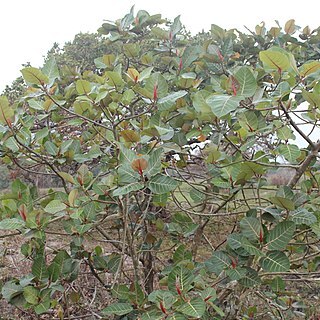Tree up to 10(–20) m. tall or a shrub, terrestrial, often with stilt or pillar roots.. Leafy twigs 3–7 mm. in diameter, glabrous or white puberulous to hirtellous, periderm not flaking off.. Leaves in spirals; lamina coriaceous, ± broadly ovate to elliptic, 6–20(–28) × 4–12(–21) cm., apex shortly acuminate to obtuse, base obtuse to cordate, margin entire; upper surface glabrous or puberulous to hirtellous on the main veins, lower surface white hirtellous to tomentellous, at least on the midrib, or sometimes glabrous; lateral veins 7–11 pairs, the basal pairs branched, reaching the margin below or sometimes at the middle of the lamina, tertiary venation partly scalariform; petiole 2–4(–7) cm. long, (1–)2–3 mm. thick, epiderm not flaking off; stipules 1.5–4.5(–8) cm. long, white puberulous to hirtellous, caducous.. Figs up to 4 together in the leaf-axils; peduncle 0.5–1 cm. long; basal bracts ± 2 mm. long, persistent.. Receptacle ± globose, 1–2 cm. in diameter when fresh, 0.5–1.5 cm. when dry, glabrous to ± densely puberulous, smooth or warted, red or yellow at maturity.
Leaves spirally arranged; lamina ± broadly ovate to elliptic, 6–20(28) x 4–12(32) cm., coriaceous; apex shortly acuminate to obtuse; base obtuse to cordate; margin entire; superior surface glabrous, puberulous to hirtellous on the main veins, inferior surface white hirtellous to tomentellous at least on the midrib, sometimes glabrous; lateral veins 7–11 pairs, the basal pair branched, ending at the margin below or sometimes at the middle of the lamina, tertiary venation partly scalariform; petiole 2–4(7) cm. long, (1)2–3 mm. thick, epidermis not flaking off; stipules 1.5–4.5(8) cm. long, white puberulous to hirtellous, caducous.
A fig. It is a small tree. It grows up to 15 m tall. The stem often lies over above water or damp ground. It has many prop roots. The bark is smooth and green to brown. The leaves are alternate and simple. The leaves are entire and heart shaped. They are large. They are 8-30 cm long by 12-23 cm wide. There are 7-11 veins on either side of the midrib. The veins are whitish above above and red below. The leaf stalk is 4.5 cm long. The figs are in the axils of leaves near the ends of branches. They are 1-2 cm across. They are bright red when ripe.
Receptacle subglobose, 10–20 mm. in diam. when fresh, 5–15 mm. in diam. when dry, glabrous or ± densely puberulous, smooth or verruculate, red to yellow at maturity.
Figs up to 4 together in the leaf axils; peduncle 5–10 mm. long; basal bracts c. 2 mm. long, persistent.
Leafy twigs 3–7 mm. in diam., glabrous or white puberulous to hirtellous, periderm not flaking off.
Tree up to 10(20) m. tall, or a shrub, terrestrial, often with stout suit-or pillar-roots.


